duty cycle
From Wikipedia, the free encyclopedia
A duty cycle is the percentage of one period in which a signal or system is active.[1][2][3] A period is the time it takes for a signal to complete an on-and-off cycle. As a formula, a duty cycle may be expressed as:
- {displaystyle D={frac {T}{P}}times 100%}
[2]
where {displaystyle D}


Duty cycles can be used to describe the percent time of an active signal in an electrical device such as the power switch in a switching power supply or the firing of action potentials by a living system such as a neuron.[4][5]
The duty factor for periodic signal expresses the same notion, but is usually scaled to a maximum of one rather than 100%.[6]
The duty cycle {displaystyle D}


Applications[edit]
Electrical & Electronics[edit]
In Electronics, duty cycle is the percentage of the ratio of pulse duration (T) to the total period (P) of the waveform. It is generally used to represent time duration of a pulse when it is high (1). In Digital Electronics, signals are used in rectangular waveform which are represented by logic 1 and logic 0. Logic 1 stands for presence of an electric pulse and 0 for absence of an electric pulse. For example a signal (10101010) has 50% Duty cycle, because the pulse remains high for 1/2 of the period or low for 1/2 of the period. Similarly, for pulse (100010001) the duty cycle will be 25% because the pulse remains high only for 1/4 of the period and remains low for 3/4 of the period. Electrical motors typically use less than a 100% duty cycle. For example, if a motor runs for one out of 100 seconds, or 1/100 of the time, then, its duty cycle is 1/100, or 1 percent.[7]
Pulse-width modulation (PWM) is used in a variety of electronic situations, such as power delivery and voltage regulation.
In electronic music, music synthesizers vary the duty cycle of their audio-frequency oscillators to obtain a subtle effect on the tone colors. This technique is known as pulse-width modulation.
In the printer / copier industry, the duty cycle specification refers to the rated throughput (that is, printed pages) of a device per month.
In a welding power supply, the maximum duty cycle is defined as the percentage of time in a 10-minute period that it can be operated continuously before overheating.[8]
Biological systems[edit]
The concept of duty cycles is also used to describe the activity of neurons and muscle fibers. In a neural network for example, a duty cycle specifically refers to the proportion of a cycle period in which a neuron remains active.[5]
Generation[edit]
One way to generate fairly accurate square wave signals with 1/n duty factor, where n is an integer, is to vary the duty cycle until the nth-harmonic is significantly suppressed. For audio-band signals, this can even be done “by ear”; for example, a -40dB reduction in the 3rd harmonic corresponds to setting the duty factor to 1/3 with a precision of 1% and -60 dB reduction corresponds to a precision of 0.1%.[9]
References[edit]
- Jump up^ Barrett, Steven Frank; Pack, Daniel J. (2006). “Timing subsystem”. Microcontrollers Fundamentals for Engineers and Scientists. Morgan and Claypool Publishers. pp. 51–64. ISBN 1-598-29058-4.
- ^ Jump up to:a b Cox, James F.; Chartrand, Leo (June 26, 2001). “Nonsinusoidal oscillators”. Fundamentals of Linear Electronics: Integrated and Discrete (2 ed.). Cengage Learning. pp. 511–584. ISBN 0-766-83018-7.
- Jump up^ “Federal Standard 1037C, “Telecommunications: Glossary of Telecommunication Terms””. Boulder, Colorado: Institute for Telecommunication Sciences. 1996. Retrieved March 3, 2011.
|section=ignored (help) - Jump up^ Brown, Martin (1990). “How a switching power supply works”. Practical Switching Power Supply Design (Motorola Series in Solid State Electronics). San Diego, CA: Academic Press. pp. 5–8. ISBN 0-121-37030-5.
- ^ Jump up to:a b Harris-Warrick, Ronald; Nagy, Frédéric; Nusbaum, Michael (1992). Harris-Warrick, Ronald; Marder, Eve; Silverston, Alan; et al., eds. Dynamic biological networks: the stomatogastric nervous system. Massachusetts: MIT Press. pp. 87–139. ISBN 0-262-08214-4.
- Jump up^ Rudolf F. Graf (1999). Modern Dictionary of Electronics. Elsevier Science. p. 225. ISBN 978-0-08-051198-6.
- Jump up^ “Electric Motors”. Machine Design. Retrieved March 23, 2011.
- Jump up^ “What does the term duty cycle mean?”. ZENA, Inc. welding systems. Retrieved March 23, 2011.
- Jump up^ William M. Hartmann (1997). Signals, Sound, and Sensation. Springer Science & Business Media. p. 109. ISBN 978-1-56396-283-7.
loads.
